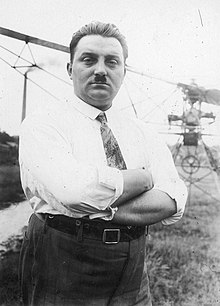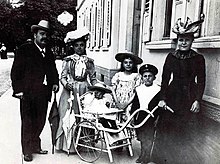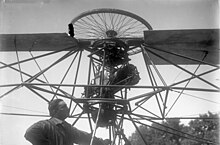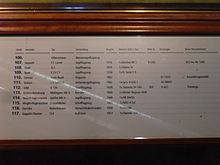Engelbert Zaschka
Engelbert Zaschka (born September 1, 1895 in Freiburg im Breisgau ; † June 26, 1955 there ) was a German engineer , designer and inventor . Zaschka is one of the first German helicopter pioneers and was a pioneer of flying with muscle power and of the folding car . He preferred to devote himself to topics from the fields of aviation and automobiles , but his work was not limited to these.
Among other things, Zaschka developed and constructed its own class of rotary wing aircraft systems with its rotary aircraft , the first collapsible and foldable small car (folding car), an early muscle- powered aircraft and its own engine systems . He applied for numerous patents . From 1921 to 1925 he was chief designer of the motorcycle Orionette the Orionette AG for motor vehicles . He published the first German-language work on gyroscopes and helicopters and wrote various technical articles.
Life
Engelbert Zaschka came from a family of musicians, his father Wenzel taught zither and played in the Freiburg city orchestra, his mother Emilie, née Rombach, was a singer; he was the second oldest of four children. He grew up on Scheffel- and Bürgerwehrstraße, where his father had the Art Nouveau apartment house No. 11 built in 1910 . At the age of 14 he applied for his first patent, founded a "hobby flying club " in Freiburg- Wiehre and allegedly made his first flight attempts at Freiburg's Schlossberg .
After attending the higher middle school in Freiburg, he went to Altenburg to study engineering . He then worked as an engineer at Rheinmetall in Düsseldorf and went to Berlin in 1916 . There he worked as chief designer at Orion Aktiengesellschaft für Motorfahrzeuge . In the 1930s and 1940s Zaschka was employed by the aircraft manufacturer Henschel . In 1926 he was registered in Berlin in the Neukölln district at Lichtenrader Strasse 59, in 1929 at Selchower Strasse 15/16 near Tempelhofer Flugfeld , in 1934 at Flughafenstrasse 21 and in 1943 at Weserstrasse 34a.
After the Second World War he settled back in Freiburg im Breisgau, where he ran a workshop ( vehicle factory, family bicycles and Zaschka vehicle factory ) at Türkenlouisstraße 47 . Zaschka died on June 26, 1955 at the age of 59 in his native city of Freiburg im Breisgau.
Inventor and engineer
Gyroscopes, helicopters and muscular power aircraft

Zaschka rotary aircraft "Z I" (1926)
In 1926-27 designed and presented Engelbert Zaschka one of the first precursor of supporting and helicopter. The basic design of the machine is in Zaschka's patent no. 573 961 , which was issued on 18./19. June 1926 was submitted in the German Reich , titled with "Hubschrauberflugzeug". His invention was subsequently also patented in the USA , Great Britain , France , Switzerland and Denmark .
“It was a historic moment for aviation when, in front of only a few spectators, the first attempt at ascent with the Zaschka aircraft at the Johannistal airfield in Berlin, an area that is closely linked by tradition with the earliest phase of German aviation went on. An unusual and surprising sight: the plane rose bolt upright; after a while the pace slowed and the plane stopped above; then it descended softly, perfectly vertically; in a straight downward flight it reached the ground again. "
Zaschka's invention is a rotary wing aircraft , a combined gyroplane and helicopter. The specialty of the Zaschka rotary aircraft was that a flywheel in the form of a horizontally rotating gyro was integrated into the two rotor blades , which was used to regulate the balance of the flight apparatus. At the same time, it acted as an energy store , which enabled safe vertical gliding when the engine was switched off . In Zaschka's patent specification "Helicopter Airplane" it says:
“ Even if it has so far been possible to build helicopters that generate sufficient lift, it has not yet been possible to achieve the stability of the jack screw and the gliding ability with the engine switched off. According to the invention, the stability of such an aircraft is now achieved in that a rotating mass is connected to a rotating wing system. By arranging a rotating flywheel mass, in addition to stability, the kinetic energy inherent in the gyro, similar to a hang glider, helps over sudden obstacles by converting it into work. "
In a test machine constructed in 1927 , a lifting screw with a diameter of 14 meters was mounted on a test stand . With an engine output of 15 hp, Zaschka succeeded in starting the 360 kilogram machine from the ground. The rotating wing made 100 revolutions per minute, while the gyroscopes had a speed of 1450 min −1 . Due to a lack of financial resources, the test series could not be continued.
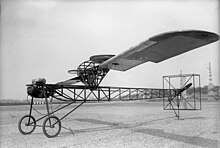
Zaschka rotary aircraft "Z II" (1928)
In 1928, Zaschka carried out experiments with another model at Berlin-Tempelhof Airport , the Zaschka helicopter or rotary aircraft , which had a wingspan of 7 meters and was equipped with a 300 cm³ DKW engine. Although these first test models only rose at a low altitude, it became clear that when the engine was braked, the apparatus slowly sank to the ground and landed undamaged.
The rotor drive of this device was already equipped with a gyroscope , which stabilized the axis against wind or against side effects of the control. Otherwise the aircraft would have been very difficult to control. For height control, the angle of attack of the rotor blades could be adjusted from the driver's seat. A propeller seated at the end of the fuselage was supposed to generate the horizontal propulsion, but was no longer tested in practice because the financial means for further test runs and further developments were lacking.
It was not until 1936 that Henrich Focke and Gerd Achgelis succeeded in developing the first fully controllable helicopter with the Focke-Wulf Fw 61 model.
Zaschka muscle power aircraft (1933-1934)

In 1934, Zaschka presented the Zaschka muscle-powered aircraft , a monoplane with a tubular steel frame and a narrow wing with a span of around 20 meters. To start the plane up to four men has been accelerated to the required starting speed.
During flight attempts on July 11, 1934, Engelbert Zaschka was able to achieve hovering flights of 20 meters at Tempelhof without external help. It was therefore a muscle-powered flight without a launch device.
Automotive and motorcycle construction
"Orionette" motorcycle (1921–1925)
From 1921 to 1925, Engelbert Zaschka played a key role in the construction of the Orionette motorcycle as chief engineer and chief designer at Orion Aktiengesellschaft für Motorfahrzeuge in Berlin . The company, also known as Orionette AG for motor vehicles, was based in the industrial yard Oranienstrasse 6 in Berlin-Kreuzberg in the 1920s and 1930s .
The Orionette AG was one of the most important companies in Berlin for cars and motorcycles of the 1920s.
Foldable car: Zaschka folding car (1928–1929)

Problems with traffic and parking spaces in large cities were already apparent in the 1920s. In 1928/1929 Engelbert Zaschka presented the first folding car in Berlin to solve this problem. Zaschka's car was foldable and could be dismantled into three parts, so it didn't need a garage, but could be parked in the apartment. The assembly and disassembly of the car should be accomplished by two people within five minutes.
A lightweight structure covered with fabric was attached to the tubular frame of the vehicle. The two front wheels were suspended individually, the rear wheel like a motorcycle . In the rear was the air-cooled single-cylinder engine , which drove the rear wheel via a spur gear ; the front radiator grille was just a dummy. The engine and transmission were firmly locked together. The car reached a top speed of 40 to 50 km / h.
To demonstrate the portability of the vehicle, Zaschka climbed the top platform of the Berlin radio tower in his first folding car in 1928 .
Series production failed due to economic and technical obstacles. The transportable car shouldn't cost more than 1,000 Reichsmarks (today: approx. 3,500 euros). The manufacture of the tubular frame was far too expensive for that. A self-supporting body would also have been too expensive to manufacture and would have made the car too heavy due to the sheet steel used . In addition, almost none of the components were sufficiently mature at that time.
Other inventions (selection)
| year | invention | Explanation |
|---|---|---|
| 1934 | Portable, mobile motor | In January 1934, Zaschka patented his invention of a mobile motor for agricultural purposes with the United States Patent and Trademark Office . Zaschka ceded half of the patent rights to the Portable Power Plant motor in 1934 to a company based in the Busch House in Hagen (Westphalia). |
| 1936/1937/1949 | 'Zaschka' folding bike | Foldable bike (folding bike). Zaschka had already built a bike that could be dismantled in 1936 and weighed only 10 kilos. "The inventor of this machine, Mr. Zaschka, a Berlin engineer, has found a solution to the bicycle parking problem. The bicycle can be folded up and easily carried or stowed in the smallest of spaces." |
| 1949/50 | 'Zaschka'-Klappski; Two-piece ski and two-piece ski poles to collapse | The skis and ski poles could be put together in ten seconds. |
Fonts
monograph
- Rotary wing aircraft. Gyroscopes and helicopters. CJE Volckmann Nachf. E. Wette, Berlin-Charlottenburg 1936, OCLC 20483709 , DNB 578463172 .
It is one of the first publications on the nature of the helicopter and helicopter. It was aimed in particular at aircraft designers and promoters of rotary wing aircraft construction.
The font is divided into A: Development history, starting with Leonardo da Vinci - B: Newer projects, attempts and successes, including Petróczy - Kármán -Zurovec, Cierva , Rieseler , Strandgren, Rohrbach , Piskorsch, Maitland-Barkelew-Bleeker, Nagler , Hafner , d'Ascanio , Florinne, Asbóth , Lamés, Bréguet-Dorand and others. C: Theory and design guidelines and D: Future prospects of the helicopter. Zaschka's own helicopters are also documented and illustrated.
In the foreword Zaschka writes:
“We may be rulers of the air and can cross continents and oceans, but we have not yet conquered the next roof with our aircraft. We hope that this dream will come true, among many other possibilities, from the helicopter. "
Article (selection)
Engelbert Zaschka published various specialist articles in technical journals, including:
- Modern construction guidelines in motorcycle construction . In: Der Motorwagen Vol. 26, No. 35–36, December 1923, pp. 488–491.
- Machine for oxy-fuel cutting of shafts . In: The motor car .
- The lady and the motorcycle. In: motorcycle sport, traffic and technology. No. 4, 1924, pp. 18-19.
Patents
Engelbert Zaschka was granted several patents between 1919 and 1953. There are currently 10 known patents, including the helicopter patents, patents on engines and on a folding bike .
Der Spiegel speaks of 82 patents that Zaschka has registered in total.
- Patent DE330202 : Arched cookware pouring lid that can be used as a grater and sieve. Registered on February 21, 1919 .
- Patent DE573961 : helicopter aircraft. Registered on June 19, 1926 .
- Patent GB272962 : Improvements in or relating to Helicopter Flying Machines. Registered on June 20, 1927 .
- Patent US1779524 : Helicopter. Registered June 29, 1927 .
- Patent DE512513 : Drive mechanism for machines with reciprocating pistons, the connecting rods of which are actuated by eccentric disks on the drive shaft. Registered on April 12, 1929 .
- Patent US1944052 : Portable power plant. Registered April 21, 1930 .
- Patent FR1019111 : Bicyclette. Registered on May 26, 1950 .
composer

As a composer Engelbert Zaschka created light music, a. a. Slavoma - the latest dance (1925), recorded at least twice: by the Bernard Etté orchestra and the Dobbri saxophone orchestra under the direction of Otto Dobrindt . He also wrote and composed the hit song Who just tied the herring to my tie? (1928).
Video on YouTube - Bernard Etté Tanz-Orchester, Slavoma, The Dance of 1925-26, Engelbert Zaschka, Modetanz.
reception

Engelbert Zaschka was a well-known German inventor, especially in the 1920s and 1930s, who also received attention in the USA . Zaschka's inventions have been reported in Germany and abroad, and photographs have appeared in scientific and popular publications in many countries. For example, E.g. the press photographer and journalist Georg Pahl in the 1920s and early 1930s Engelbert Zaschka with his inventions. Newspapers such as the New York Times , Washington Post , The Argus ( Melbourne ), Diario ABC ( Madrid ) and Daily Mirror ( London ) published articles about Zaschka's helicopter developments. The report highlights the first technical successes as well as the expectations and future prospects associated with Zaschka's construction. For example, The Bee ( Danville , Virginia ) wrote:
“His [Engelbert Zaschka's] plane, the first helicopter, which ever worked so successfully in miniature, not only rises and descends vertically, but is able to remain stationary at any height. German airplane experts assert that such a flight as that of Captain [Charles] Lindbergh's from New York to Paris would not even be a feat for Zaschka's plane when it was perfected. [...] Mr. Zaschka is fully aware that the perfection of his invention will be the greatest forward step in aviation since the Wright brothers made their historical hop. As he pointed out, the danger of flying would immediately be decreased by at least 80 per cent, since four fifths of the accidents in flying occur either in the takeoff or in landing. […] A motor giving thirty to forty horsepower is installed in Zaschka's present experimental machine. It is so delicately adjusted that he has been able to keep the plane at a height of several feet above the ground, with no movement either up or down. "
“His [Engelbert Zaschkas] airplane - the first helicopter that ever worked so successfully in miniature - not only rises and falls vertically, but is also able to stop at any height. German aviation experts explain that a flight like Captain [Charles] Lindbergh's from New York to Paris would not even be a feat for Zaschka's plane if it were perfected. [...] Mr. Zaschka is fully aware that perfecting his invention will be the greatest advance in aviation since the Wright brothers made their historic leap. As he explained, the risk of flying is immediately reduced by at least 80 percent, since 4/5 of the aircraft accidents occurred either during take-off or landing. [...] A motor with 30 to 40 hp is built into Zaschka's current test machine. This is so finely regulated that it was able to keep the aircraft at a height of several feet above the ground without moving up or down. "
Since Zaschka's projects (like that of the gyrocopter and helicopter) ultimately did not materialize due to a lack of financial resources, he was largely forgotten in the period that followed. The National Air and Space Museum in Washington, DC has an archive inventory with documents and photographs ( Zaschka Document and Photograph Files ) of the Zaschka aircraft and helicopter as well as the Zaschka muscle-powered aircraft .
The History of Aviation Collection of the University of Texas at Dallas contains, among other things, the collection of the US Navy Admiral Charles E. Rosendahl . In the Vice Admiral Charles E. Rosendahl Lighter-than-Air Collection ( lighter-than-air technology collection) are photographs of early aviation pioneers like Engelbert Zaschka and his helicopter.
On behalf of the German Museum of Technology Berlin, Holger Steinle is still looking for exhibits from the German Aviation Collection Berlin . The museum is currently looking for, among other things, the prototype of the Zaschka helicopter , which was part of the museum inventory of the German Aviation Collection until 1941.
Richard A. Lupoff engages in his novel Marblehead. A Novel of HP Lovecraft (2006) the helicopter invention by Engelbert Zaschka from 1927.
literature
- Karl Ries: Air Force. The Moles (1919–1935) . Verlag Dieter Hoffmann, Mainz 1970, DNB , p. 36.
- John Foster Fay: The Helicopter. History, Piloting and How It Flies. David & Charles PLC, 1976, ISBN 0-7153-7249-1 . P. 135.
- David Anthony Reay: The history of man-powered flight. Pergamon Press, Oxford / New York 1977, ISBN 0-08-021738-9 , p. 101.
- Ludwig Bölkow : A century of aircraft. History and technology of flight. Springer-Verlag, Berlin 1990, ISBN 3-18-400816-9 , p. 442.
- Heinz J. Nowarra: German Helicopters 1928–1945. Schiffer Publishing, 1991, ISBN 0-88740-289-5 , p. 4.
- Michael Graf Wolff Metternich: 100 years on 3 wheels. German three-lane vehicles through the ages. Neue Kunst, Munich 1992, ISBN 3-929956-00-4 , p.?.
- Rolf Besser: Technology and History of the Helicopter. From Leonardo da Vinci to the present. Bernard & Graefe, Bonn 1996, ISBN 3-7637-5965-4 , p. 65.
- Morton Grosser: Gossamer Odyssey. The Triumph of Human-powered Flight. Zenith Press, 2004, ISBN 0-7603-2051-9 , pp. 14-15.
- Michaela Behrens: City Talks from Neukölln. Gmeiner-Verlag, Meßkirch 2014, ISBN 978-3-8392-1559-3 , pp. 167-168.
- Sasha Disko: The Devil's Wheels. Men and Motorcycling in the Weimar Republic. Berghahn Books, New York / Oxford 2016, ISBN 978-1-78533-169-5 , pp. 314-320.
TV documentaries in which Zaschka is treated
- Big ideas - small flops: flashes of inspiration from A to Z. Documentation, Germany, 2016, 90 minutes, authors: Andreas Kölmel and Jürgen Vogt; Production: SWR TV , German first broadcast: May 16, 2016; Documentation information ; Documentation excerpt " Zaschka ": YouTube .
- Technical stories from the southwest - the helicopter. Documentation, Germany 2018, 45 minutes, authors: Ulrike Gehring and Isabelle Arnold; Interview partner: Holger Steinle ; Production: SWR TV and Screen-Art Production Frankfurt am Main, German first broadcast: January 15, 2019; Documentation information ; Documentation excerpt: YouTube.
Web links
- Literature by and about Engelbert Zaschka in the catalog of the German National Library
- Zaschka at the National Air and Space Museum
- Zaschka helicopter 1928 at All the World's Helicopters and Rotorcraft
- Helicopter types from 1910 to 1929 (see 1928) at The Helicopter Page
- Zaschka helicopter at Lost Art Internet Database (German Center for Cultural Losses)
- Engelbert Zaschka - photographs in the holdings of the Federal Archives
Newspaper and online articles (selection)
- Says His Helicopter Can Halt in Flight; Midair Transfer of Passengers Predicted , article about Zaschka's helicopter in the New York Times , published June 4, 1927 (English)
- Tom Ray: Las Máquinas Voladoras del Porvenir , Diario ABC , Madrid, published on September 23, 1928, pages 100-101 (Spanish)
- Airplane that rises vertically , The Argus ( Melbourne , Australia), published October 27, 1928 (English)
- Ski in a backpack , Hamburger Abendblatt , published on January 28, 1950
- Not according to my plans , Der Spiegel , Spiegel article with photos of Engelbert Zaschka, his folding ski and folding bike, published on February 9, 1950 (PDF)
- A Käpsele called Engelbert Zaschka , FACETTEN-Magazin, appeared on April 28, 2015
- Nicola Schwannauer: Tinkerer Zaschka: a Freiburg resident who got everything small. In: Badische Zeitung. May 15, 2016. Retrieved February 15, 2017 .
- Giorgos Christides: world record 1988: cycling through the air. In: SPIEGEL ONLINE. April 23, 2018. Retrieved June 12, 2018 .
Individual evidence
- ↑ Date and place of birth: birth certificate. Registry office Freiburg im Breisgau No. 937/1895: Engelbert Zaschka; Date and place of death: City of Freiburg im Breisgau, own operation of cemeteries: Engelbert Zaschka, January 24, 2008.
- ↑ Engelbert Zaschka: rotary wing aircraft. Gyroscopes and helicopters. CJE Volckmann Nachf. E. Wette, Berlin-Charlottenburg 1936, p. 57.
- ↑ a b Hiriko Fold - An Electric Car That Folds for Easy Parking , accessed December 4, 2012.
- ↑ a b c d National Air and Space Museum: Zaschka Human-Power Aircraft (1934) .
- ↑ See The European Patent Office Homepage (EPO) , accessed on November 20, 2009.
- ↑ Berend G. van der Wall: Fundamentals of helicopter aerodynamics . Springer-Verlag, Berlin / Heidelberg 2015, ISBN 978-3-662-44399-6 , pp. 4 .
- ^ Wenzel Zaschka in the Bavarian Musicians' Lexicon Online (BMLO) .
- ↑ All information on life according to the inventor Zaschka: a Freiburg native who got everything small . In: Badische Zeitung , May 15, 2016.
- ↑ Joanna Flawia Figiel: Art Nouveau in Freiburg . Kore, Freiburg 1999, ISBN 3-933056-32-2 , p. 317.
- ↑ A Käpsele called Engelbert Zaschka , in Facetten Magazin Neukölln April 25, 2015.
- ^ Entry in the official population register of the city of Freiburg im Breisgau and the surrounding area 1950, p. 250 ; Deutsches Museum: Deutsches Museum: Z. Accessed March 24, 2017 .
- ↑ See The European Patent Office Homepage (EPO) , accessed on June 2, 2011.
- ↑ a b c d e Engelbert Zaschka: rotary wing aircraft. Gyroscopes and helicopters. CJE Volckmann Nachf. E. Wette, Berlin-Charlottenburg 1936, p. 47.
- ↑ See Reichsflugverein: Zeitschrift für Flugtechnik und Motorluftschiffahrt , Volume 22, 1931, p. 288.
- ↑ Cf. Kyrill von Gersdorff, Kurt Knobling: helicopter and gyrocopter . Bernard & Graefe, Bonn 1999, p. 20.
- ↑ Rolf Besser: Technology and history of the helicopter: From Leonardo da Vinci to the present. Bernard & Graefe Verlag, Bonn 1996, p. 65.
- ^ Morton Grosser: Gossamer Odyssey. The Triumph of Human-powered Flight . Zenith Press, 2004, pp. 14-15.
- ↑ Bruno Lange: The book of German aviation technology. Verlag Dieter Hoffmann, Mainz 1970, p. 361.
- ↑ See Der Deutsche Sportflieger , Vol. 2, No. 10, October 1935, p.?.
- ↑ See Karl Reese: Motorcycles from Berlin. 2002, ISBN 3-935517-05-X , p. 103.
- ↑ Otto Meibes: The development of the German automotive industry. Halle 1926, p. 166.
- ↑ This is where Konrad Zuse , the inventor of the computer, completed the first program-controlled and freely programmable computer " Z3 " in 1941 .
- ↑ See Industriehof Oranienstrasse - Berliner Bezirkslexikon, Friedrichshain-Kreuzberg, Edition Luisenstadt , as of October 7, 2009.
- ↑ Cf. Kurt Doogs: The Berlin machine industry and its production conditions since its inception , dissertation TH Berlin 1928, p. 78.
- ↑ a b Marián Šuman-Hreblay: Automobile Manufacturers Worldwide Registry. McFarland & Company, Inc., Publishers, London 2000, p. 311.
- ↑ a b c Not according to my plans . In: Der Spiegel , February 9, 1950.
- ↑ a b c d Parking in the living room: The collapsible small car by the Berlin inventor Engelbert Zaschka from 1929 // Franke-Brandau, Claudia. - In: Oldtimer Market . ISSN 0939-9704 1993, 7, p. 206 with 3 illustrations.
- ↑ a b See Come-Apart Auto Invented . In: The Massena Observer , New York State, March 12, 1931, p. 3.
- ↑ FreePatentsOnline.com: Helicopter auxiliary energy system , US Patent Reference: 1779524 .
- ↑ United States Patent 1,944,052: "Mobile, portable power plant or motor" published January 16, 1934.
- ↑ a b See The European Patent Office Homepage (EPO) , accessed on November 22, 2011.
- ↑ ANNO, Austrian sewing machine and bicycle newspaper, 1936-09-25, page 14. Accessed on May 11, 2020 .
- ↑ THIS MAY SOLVE A PROBLEM . In: Herald (Melbourne, Vic .: 1861-1954) . Melbourne, Vic. February 2, 1937, p. 8 ( gov.au [accessed May 22, 2020]).
- ↑ a b German Press Agency ( dpa ): Skis in a backpack. In: Hamburger Abendblatt of January 28, 1950, No. 24, p. 2.
- ^ American Society of Mechanical Engineers: The Engineering Index. 1969, p. 463.
- ↑ Peter Kirchberg (Ed.): The best from "Der Motorwagen" magazine for the automotive industry and engine construction , Solingen 1988, p. 60.
- ↑ The year of the first application for a patent is indicated. Invention , patent application , patent grant and start of marketing can fall in different calendar years. This is the reason for different statements in publications.
- ^ Vox 2404-A
- ^ Carl Lindström A.-G .: Label "Beka" (LC 0026), catalog number B 5402, die number 33126 .
- ↑ Published by Rondo-Verlag, Musical-literary monthly report 1928, p. 51 .
- ^ German Plane Promises New Stunts In Air. In: Kokomo Daily Tribune , Kokomo , Indiana , June 27, 1927, p. 16.
- ^ See What Others Think About It , Los Angeles Times , Feb. 7, 1930
- ↑ Cf. holdings "Image 102 Current-Images-Centrale, Georg Pahl". In: Digital Image Archive of the Federal Archives.
- ^ Daily Mirror , Tuesday June 7, 1927, p. 3.
- ↑ Guide to Charles E. Rosendahl Collection , accessed March 20, 2017.
- ↑ The search may a. via the Lost Art Internet Database , which is operated by the Coordination Office for the Loss of Cultural Property in Magdeburg . German Loss of Cultural Property Center: Lost Art Internet Database - Institution loss: Zaschka helicopter .
- ↑ See Richard A. Lupoff: Marblehead. A Novel of HP Lovecraft. 2006, ISBN 1-60543-282-2 , p. 220.
| personal data | |
|---|---|
| SURNAME | Zaschka, Engelbert |
| BRIEF DESCRIPTION | German engineer, designer, inventor and helicopter pioneer |
| DATE OF BIRTH | September 1, 1895 |
| PLACE OF BIRTH | Freiburg in Breisgau |
| DATE OF DEATH | June 26, 1955 |
| Place of death | Freiburg in Breisgau |
